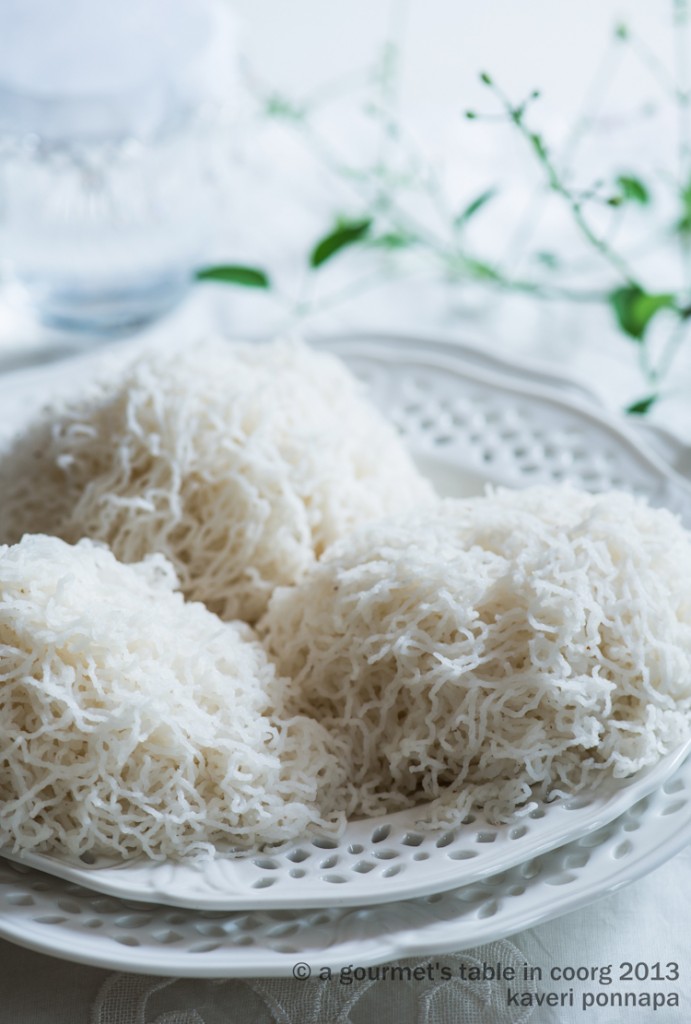The beauty of Coorg deepens towards the end of the year, when acre after acre of paddy grows tall, slender stalks, first translucent, then a vivid green, complementing the indigo hills. In late November or December, the crop is harvested and welcomed into homes in the greatest celebration of the year, putari. Rice is everywhere – hung in sheaves over lit lamps, kitchens, granaries, cowsheds; in powder palm prints and stencils on walls and, of course, on the table. Rice defines the cuisine of Coorg. We eat the oven-top flatbreads (akki ottis), neer dosas, rice dosas and heaps of the increasingly rare, pearly, sannakki, small-grained and fragrant. But washed, dried and hand pounded, the grains broken, each into roughly three, rice becomes tari, which, cooked and steamed, is transformed into enticing puttus. And this is where the story of Coorg cuisine begins.
It is impossible to exaggerate the charms of the puttu. Each is unique in shape and texture, boasting individual character and temperament. There’s the firm and pleasing resistance of the round Kadambuttus; the soft, delicate strands of noolputtu, similar to idi appams, but softer and moister; the creamy, coconut-tinged paputtu, steamed into flat cakes and plain and dependable thaliyaputtu. Like the great couples of the world, Anthony and Cleopatra, Romeo and Juliet, the names of individual puttus and currys are spoken together, seemingly inseparable companions. Kadambuttus go with pandi curry; noolputtus and chicken curry; paputtus and mutton curry.
Away from these classic combinations they retain their individuality and can be eaten at breakfast, lunch or dinner. Paputtu and kadambuttu are eaten with homemade butter or ghee, and golden Coorg honey. Day old noolputtus are often eaten at breakfast soaked in a thin, cardamom scented syrup of jaggrey, with shavings of fresh coconut. If they outlast breakfast, they are sun dried on sheets of newspaper, deep fried into crunchy strands and sprinkled with copious amounts of granulated sugar and scraped coconut. A shout usually brings the children of the house scampering in to grab fistfuls of this delicious concoction, before they run away again, to play. Leftover Kadambuttus were sliced in half and fried, in less calorie conscious days, into a snack. Paputtus and thaliyaputtus can be cooked sweetened, completely changing their flavour and temperament.
There are sweet puttus of ripened jackfruit or banana pulp, wrapped up in koovale leaves and steamed. Others of roasted, powdered par-boiled rice and jaggery and many more that would take pages of description. Through all of them, the presence of rice runs in a connecting thread. Despite the dwindling rice fields of Coorg, the sacred grain remains at the heart of our culture, rituals and cuisine. From our very generous land, rice is one of the richest gifts, especially when cooked into a puttu.
Nool Puttu
Steamed thread-puttus
- 3 cups tari or idly rava (broken rice)
- 6 cups water (approx)
- a pinch of salt
- 1 tablespoon ghee
- 1 teaspoon cardamom, powdered
- ( 3 cups tari will give you about 12 noolputtus)
Keep a steamer ready, with water simmering.
Method:
- Bring the water, to which the cardamom powder, salt and ghee have been added to a boil.
- Add the tari, and cook, stirring, on a medium heat to make a thick, moist dough. 3) Grease palms of the hand with ghee.
- Take tennis ball sized handfuls of the dough, and mold into a roughly cylindrical shape.
- Place the balls of dough in a thin muslin cloth, cover, and place in steamer for about 15 – 20 mins.
- Using a nool puttu press, squeeze out each ball of cooked rice onto a saucer lightly greased with ghee. Rotate the saucer as the dough is squeezed out, so that the puttu is a circular mound. Serve with chicken curry and melted ghee.
If a nool puttu press is not part of your kitchen, a chakkali press with close-set perforations will do.
Thank you for visiting this page. If you read something that you enjoy, or see an image that you like, please take a moment to write a response. Do look out for the recipes of all the food featured here in my upcoming cookbook.
Image Credits: Nithin Sagi
All Food Styling: Kaveri Ponnapa





Woww! Reading your post reminds me of all the flavours of coorg that
I enjoyed in my childhood! Thank you for the recipes and the beautiful descriptions!
Hello Kavya, I’m so glad that you enjoyed reading this post and that it brought back memories.
Happy Puthari! Warm wishes,Kaveri.
So familiar and yet so unfamiliar. The idiyappam or noolputtu as we make it in Kerala, is pressed directly in noodle strands and then steamed. I wonder how different the texture would be between these two processes.
Hello Maria, welcome to The Coorg Table! You have put it so well, “familiar yet so unfamiliar…” I have tasted idiyappams several times, and the difference is this: idiyappams offer a great deal of resistance, compared with noolputtus. They are flatter and more elastic. Noolputtus, on the other hand, are very soft and pliant,and press out into a rounded heap, but are still able to hold their shape and texture. They also soak a gravy faster than idiyappams. I hope you will try out the noolputtu recipe – they are really quite exquisite. Warm wishes.Kaveri
So glad I’m headed for Coorg on Friday, or I wouldn’t be able to bear the pangs of reading this glorious description.
Saras,just back from a perfect Putari in Coorg – very cold, clear night, a huge,silver moon,fire crackers across the fields, rice paste stencils to decorate homes, sheaves of freshly harvested paddy and everyone chanting “Poli poli Deva”. The best part of the year for all of us.